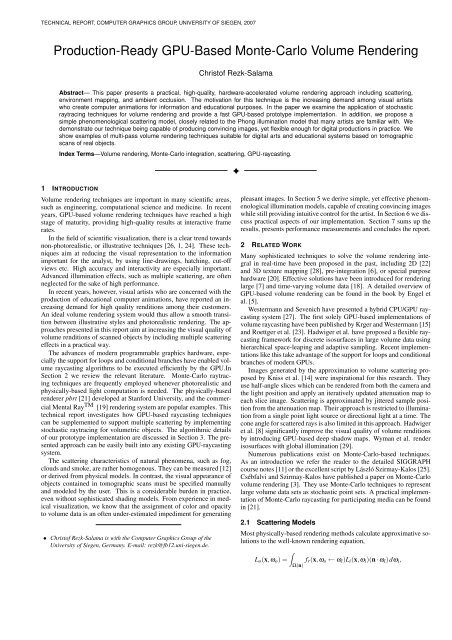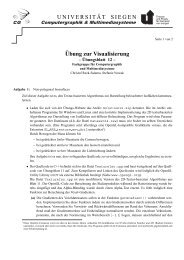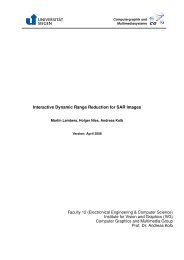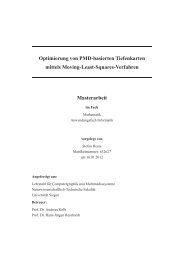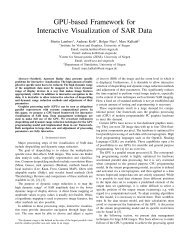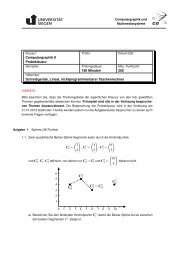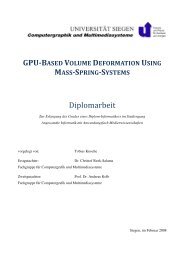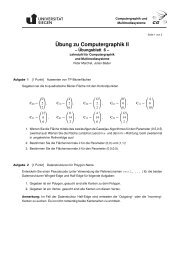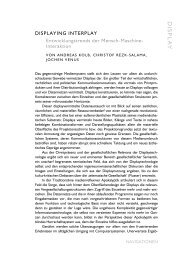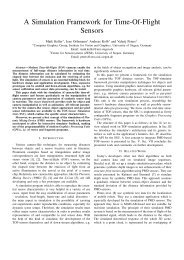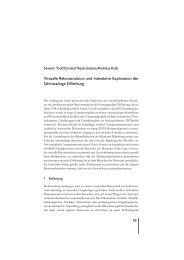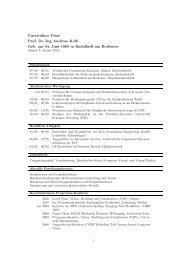Production-Ready GPU-Based Monte-Carlo Volume Rendering
Production-Ready GPU-Based Monte-Carlo Volume Rendering
Production-Ready GPU-Based Monte-Carlo Volume Rendering
You also want an ePaper? Increase the reach of your titles
YUMPU automatically turns print PDFs into web optimized ePapers that Google loves.
TECHNICAL REPORT, COMPUTER GRAPHICS GROUP, UNIVERSITY OF SIEGEN, 2007<br />
<strong>Production</strong>-<strong>Ready</strong> <strong>GPU</strong>-<strong>Based</strong> <strong>Monte</strong>-<strong>Carlo</strong> <strong>Volume</strong> <strong>Rendering</strong><br />
Christof Rezk-Salama<br />
Abstract— This paper presents a practical, high-quality, hardware-accelerated volume rendering approach including scattering,<br />
environment mapping, and ambient occlusion. The motivation for this technique is the increasing demand among visual artists<br />
who create computer animations for information and educational purposes. In the paper we examine the application of stochastic<br />
raytracing techniques for volume rendering and provide a fast <strong>GPU</strong>-based prototype implementation. In addition, we propose a<br />
simple phenomenological scattering model, closely related to the Phong illumination model that many artists are familiar with. We<br />
demonstrate our technique being capable of producing convincing images, yet flexible enough for digital productions in practice. We<br />
show examples of multi-pass volume rendering techniques suitable for digital arts and educational systems based on tomographic<br />
scans of real objects.<br />
Index Terms—<strong>Volume</strong> rendering, <strong>Monte</strong>-<strong>Carlo</strong> integration, scattering, <strong>GPU</strong>-raycasting.<br />
✦<br />
1 INTRODUCTION<br />
<strong>Volume</strong> rendering techniques are important in many scientific areas,<br />
such as engineering, computational science and medicine. In recent<br />
years, <strong>GPU</strong>-based volume rendering techniques have reached a high<br />
stage of maturity, providing high-quality results at interactive frame<br />
rates.<br />
In the field of scientific visualization, there is a clear trend towards<br />
non-photorealistic, or illustrative techniques [26, 1, 24]. These techniques<br />
aim at reducing the visual representation to the information<br />
important for the analyst, by using line-drawings, hatching, cut-off<br />
views etc. High accuracy and interactivity are especially important.<br />
Advanced illumination effects, such as multiple scattering, are often<br />
neglected for the sake of high performance.<br />
In recent years, however, visual artists who are concerned with the<br />
production of educational computer animations, have reported an increasing<br />
demand for high quality renditions among their customers.<br />
An ideal volume rendering system would thus allow a smooth transition<br />
between illustrative styles and photorealistic rendering. The approaches<br />
presented in this report aim at increasing the visual quality of<br />
volume renditions of scanned objects by including multiple scattering<br />
effects in a practical way.<br />
The advances of modern programmable graphics hardware, especially<br />
the support for loops and conditional branches have enabled volume<br />
raycasting algorithms to be executed efficiently by the <strong>GPU</strong>.In<br />
Section 2 we review the relevant literature. <strong>Monte</strong>-<strong>Carlo</strong> raytracing<br />
techniques are frequently employed whenever photorealistic and<br />
physically-based light computation is needed. The physically-based<br />
renderer pbrt [21] developed at Stanford University, and the commercial<br />
Mental Ray TM [19] rendering system are popular examples. This<br />
technical report investigates how <strong>GPU</strong>-based raycasting techniques<br />
can be supplemented to support multiple scattering by implementing<br />
stochastic raytracing for volumetric objects. The algorithmic details<br />
of our prototype implementation are discussed in Section 3. The presented<br />
approach can be easily built into any existing <strong>GPU</strong>-raycasting<br />
system.<br />
The scattering characteristics of natural phenomena, such as fog,<br />
clouds and smoke, are rather homogenous. They can be measured [12]<br />
or derived from physical models. In contrast, the visual appearance of<br />
objects contained in tomographic scans must be specified manually<br />
and modeled by the user. This is a considerable burden in practice,<br />
even without sophisticated shading models. From experience in medical<br />
visualization, we know that the assignment of color and opacity<br />
to volume data is an often under-estimated impediment for generating<br />
• Christof Rezk-Salama is with the Computer Graphics Group of the<br />
University of Siegen, Germany. E-mail: rezk@fb12.uni-siegen.de.<br />
pleasant images. In Section 5 we derive simple, yet effective phenomenological<br />
illumination models, capable of creating convincing images<br />
while still providing intuitive control for the artist. In Section 6 we discuss<br />
practical aspects of our implementation. Section 7 sums up the<br />
results, presents performance measurements and concludes the report.<br />
2 RELATED WORK<br />
Many sophisticated techniques to solve the volume rendering integral<br />
in real-time have been proposed in the past, including 2D [22]<br />
and 3D texture mapping [28], pre-integration [6], or special purpose<br />
hardware [20]. Effective solutions have been introduced for rendering<br />
large [7] and time-varying volume data [18]. A detailed overview of<br />
<strong>GPU</strong>-based volume rendering can be found in the book by Engel et<br />
al. [5].<br />
Westermann and Sevenich have presented a hybrid CPU/<strong>GPU</strong> raycasting<br />
system [27]. The first solely <strong>GPU</strong>-based implementations of<br />
volume raycasting have been published by Krger and Westermann [15]<br />
and Roettger et al. [23]. Hadwiger et al. have proposed a flexible raycasting<br />
framework for discrete isosurfaces in large volume data using<br />
hierarchical space-leaping and adaptive sampling. Recent implementations<br />
like this take advantage of the support for loops and conditional<br />
branches of modern <strong>GPU</strong>s.<br />
Images generated by the approximation to volume scattering proposed<br />
by Kniss et al. [14] were inspirational for this research. They<br />
use half-angle slices which can be rendered from both the camera and<br />
the light position and apply an iteratively updated attenuation map to<br />
each slice image. Scattering is approximated by jittered sample position<br />
from the attenuation map. Their approach is restricted to illumination<br />
from a single point light source or directional light at a time. The<br />
cone angle for scattered rays is also limited in this approach. Hadwiger<br />
et al. [8] significantly improve the visual quality of volume renditions<br />
by introducing <strong>GPU</strong>-based deep shadow maps. Wyman et al. render<br />
isosurfaces with global illumination [29].<br />
Numerous publications exist on <strong>Monte</strong>-<strong>Carlo</strong>-based techniques.<br />
As an introduction we refer the reader to the detailed SIGGRAPH<br />
course notes [11] or the excellent script by László Szirmay-Kalos [25].<br />
Csébfalvi and Szirmay-Kalos have published a paper on <strong>Monte</strong>-<strong>Carlo</strong><br />
volume rendering [3]. They use <strong>Monte</strong>-<strong>Carlo</strong> techniques to represent<br />
large volume data sets as stochastic point sets. A practical implementation<br />
of <strong>Monte</strong>-<strong>Carlo</strong> raycasting for participating media can be found<br />
in [21].<br />
2.1 Scattering Models<br />
Most physically-based rendering methods calculate approximative solutions<br />
to the well-known rendering equation,<br />
∫<br />
L o (x,ω o ) = f r (x,ω o ← ω i )L i (x,ω i )(n · ω i )dω i ,<br />
Ω(n)
TECHNICAL REPORT, COMPUTER GRAPHICS GROUP, UNIVERSITY OF SIEGEN, 2007<br />
which is derived from the Boltzmann equations. It describes the scattering<br />
events at a point x on a surface. L o is the outgoing radiance<br />
which leaves the surface in direction ω o . It is computed as the integral<br />
of the incoming radiance L i over the hemisphere Ω centered around<br />
the surface normal n. The incoming radiance is weighted by the bidirectional<br />
reflectance distribution function f r (BRDF) and the cosine<br />
of the angle of incidence cosθ i = (n · ω i ). Most surface rendering<br />
techniques assume light transport in a vacuum. In this case scattering<br />
events are taking place at object boundaries only.<br />
Inside of natural phenomena scattering events are considered to potentially<br />
happen at every point inside this participating medium. In this<br />
case, the BRDF f r is replaced by the phase function p, and incoming<br />
radiance is integrated over the entire sphere S 2 ,<br />
∫<br />
L o (x,ω o ) = p(x,ω o ← ω i )L i (x,ω i )dω i .<br />
S 2<br />
The phase function describes the scattering characteristics of the participating<br />
medium. The most popular phase function models are<br />
Henyey-Greenstein, Schlick, Mie and Rayleigh (see [10, 5, 21]). Note<br />
that the cosine term from Equation is omitted in Equation , since<br />
the phase function directly operates on radiance values rather than differential<br />
irradiance like the BRDF. For clarity, the optional emission<br />
term was also omitted in Equation .<br />
For semi-transparent surfaces, scattering events are still considered<br />
to happen only at surface boundaries, but light can be transmitted<br />
through transparent or translucent materials. The BRDF in Equation<br />
is supplemented by a bidirectional transmittance distribution<br />
function (BTDF) f t defined on the opposite hemisphere. Both the<br />
BRDF and the BTDF are often considered together as a single bidirectional<br />
scattering distribution function f (BSDF). The BSDF leads<br />
to a rendering equation according to<br />
∫<br />
L o (x,ω o ) = f (x,ω o ← ω i )L i (x,ω i )‖(n · ω i )‖dω i ,<br />
S 2<br />
Material properties of translucent surfaces, such as skin or paper,<br />
are often modeled using the bidirectional surface scattering reflectance<br />
distribution function (BSSRDF), which require two surface<br />
locations to be specified. A practical model has been proposed by<br />
Jensen et al. [12]. Donner et al.[4] have supplemented this model for<br />
multi-layered translucent materials. Interactive rendering technique<br />
for translucent surfaces have been presented by Lensch et al. [17] and<br />
Carr et al. [2]<br />
The phase function can be considered as a generalization of the<br />
BSDF. Phase functions are ideal for modeling natural phenomena.<br />
They can be measured or derived from physical models. For objects<br />
contained in tomographic scans, however, it is not very intuitive to<br />
specify varying phase functions. We therefore prefer the notion of the<br />
BSDF, since it contains the normal vector which represents the orientation<br />
of surface-like structures. We can replace the surface normal by<br />
the isosurface normal of the volume, which coincides with the normalized<br />
gradient vector (except for homogenous regions).<br />
The principle of <strong>Monte</strong>-<strong>Carlo</strong> integration is to estimate the complex<br />
integrals from the previous section by a sum of randomized samples,<br />
∫<br />
S 2 g(x)dx ≈ 1 N<br />
N g(x i )<br />
∑<br />
i=1 p(x i )<br />
with x i being a random variable with probability density function<br />
p(x i ). In practice this means that for each pixel multiple viewing rays<br />
are cast and the radiance contributions of all rays are averaged.<br />
3 <strong>GPU</strong>-BASED MONTE-CARLO RAYCASTING<br />
Existing implementations of <strong>GPU</strong>-based raycasting sample the volume<br />
successively along a viewing ray and calculate a solution of light<br />
transfer in the absence of scattering events. If the volume data set<br />
is represented by a 3D texture, however, we have the freedom to reflect<br />
the ray into an arbitrary direction at any point inside the volume.<br />
(1)<br />
Random directions can be pre-computed, stored in additional texture<br />
images and accessed via randomized texture coordinates.<br />
As an initial implementation, we modify the fragment program for<br />
<strong>GPU</strong>-raycasting to calculate the first directional derivative of the scalar<br />
field along the viewing ray using central differences. If the magnitude<br />
of the first derivative is larger than a specified threshold, we assume a<br />
scattering event. We process the scattering event by obtaining a randomized<br />
direction from a pre-computed texture and reflect the ray into<br />
this direction. The user-specified threshold restricts scattering events<br />
to inhomogenous regions of the volume, while rays may pass through<br />
homogenous regions unimpededly.<br />
We restart the fragment program for <strong>GPU</strong>-based raycasting multiple<br />
times with different random values. The program samples the<br />
volume at equidistant positions along the ray and integrate the phase<br />
function while the ray travels through the volume. We will terminate<br />
the viewing ray whenever the radiance contribution of the ray falls below<br />
a specified threshold ε due to continuous attenuation. When the<br />
viewing ray leaves the volume’s bounding box, the incident radiance<br />
is sampled from an environment cube map. The accumulated radiance<br />
RGB triplet is finally written into the frame buffer and averaged with<br />
the previous passes.<br />
This initial implementation has several shortcomings:<br />
• The precomputed randomized ray directions do not account for<br />
the directions with dominant radiance contribution. The convergence<br />
is slow, because many rays are wasted in areas with only<br />
little contribution.<br />
• Many rays are terminated due to low attenuation and do not contribute<br />
to the final image.<br />
• The visual appearance of the volumetric object is hard to control<br />
by the artist.<br />
• Many calculations, such as determination of the first scattering<br />
event, are performed repeatedly in successive passes.<br />
The first problem is tackled by the use of importance sampling, as<br />
described in Section 4. The second and third problems are solved<br />
by multi-layer rendering technique which controls the reflection and<br />
transmission events. Details for the multiple passes are explained in<br />
Section 6.<br />
To improve the fourth shortcoming, we use a multi-pass rendering<br />
technique to reuse as much information as possible. In a first rendering<br />
pass the front faces of the bounding box are rasterized. This first pass<br />
simultaneously renders into two floating-point off-screen buffers using<br />
the multiple-render-targets capabilities of modern <strong>GPU</strong>s. As outlined<br />
above, the fragment shader contains a loop that successively samples<br />
the volume along the viewing ray. The user specifies the scalar values<br />
for a set of isosurfaces, at which scattering events should be computed.<br />
While sampling the volume along the ray, we continuously check if<br />
one of the specified isosurfaces was intersected. If the first isosurface<br />
is hit, the shader breaks out of the loop.<br />
To improve accuracy, a few iterations of interval bisection are performed<br />
to come closer to the exact intersection point, as suggested<br />
in [9]. The 3D texture coordinate of the intersection point is written<br />
to the first render target. Finally, the fragment program obtains six<br />
additional texture samples around the intersection point to estimate<br />
the gradient vector using central differences. The gradient magnitude<br />
is calculated, and the vector is then normalized. The orientation of<br />
the gradient is negated if the viewing vector points into the opposite<br />
hemisphere. In this case the gradient magnitude is also negated to keep<br />
track of this modification. Gradient direction and magnitude are stored<br />
as a floating-point RGBA quadruplet in the second render target and<br />
the fragment program terminates. The contents of the two render targets<br />
for the first-hit pass are shown in Figure 1. Successive rendering<br />
passes start the ray integration directly at the intersection point with<br />
the first isosurface by reading the 3D texture coordinate determined in<br />
the first pass.
CHRISTOF REZK SALAMA: PRODUCTION-READY <strong>GPU</strong>-BASED MONTE-CARLO VOLUME RENDERING<br />
Fig. 1. Results of the rendering passes. Far left: texture coordinate of the first isosurface hit. Left: Gradient vector of the first isosurface. Right:<br />
Beauty pass for the first isosurface. Far right: Ambient occlusion pass for the first isosurface.<br />
4 SAMPLING SCHEMES<br />
Importance sampling is an effective means of increasing the rendering<br />
performance by reducing the variance of the <strong>Monte</strong>-<strong>Carlo</strong> estimator.<br />
More samples are placed in regions of the parameter domain where<br />
the function to be integrated is expected to be large, while fewer samples<br />
are used in regions where only a small contribution to the integral<br />
is assumed. While software implementation have the flexibility to employ<br />
arbitrary probability distributions and tailor them to the specific<br />
integrand in Equation 1, our <strong>GPU</strong>-based implementation must work<br />
with the same probability distribution for all scattering events due to<br />
the parallel nature of fragment programs.<br />
We decided to use random directions uniformly distributed on the<br />
unit sphere as basis and employ simple but effective strategies to omit<br />
regions with only little contribution according to the phase function<br />
or BSDF. To avoid the necessity to account for different probability<br />
distributions p(x), we restrict ourselves to uniform distributions. Uniform<br />
samples are admittedly not the optimal sampling schemes, but<br />
they allow us to remove p(x) from the sum in Equation 1 and replace<br />
the weighted sum by a simple average for efficiency.<br />
For a fast access to randomized direction vectors from within a fragment<br />
shader, we use a pre-computed set of random value triplets representing<br />
points uniformly distributed on the unit sphere. We generate<br />
such vectors by the use of rejection sampling: We obtain triplets r S<br />
of uniformly distributed random values in the range of [−1,1]. We<br />
discard all vectors with a magnitude larger than 1 and normalize the<br />
remaining vectors to unit length. The pre-computed random vectors<br />
are stored in a 3D texture. By sampling the texture at runtime, we can<br />
generate samples uniformly distributed on the unit sphere. Alternatively,<br />
area-preserving parameterizations can be used to generate the<br />
random vectors [11].<br />
The random directions obtained from the texture can directly be<br />
used to sample the phase function. For diffuse, surface-like reflection,<br />
however, it is necessary to restrict the random directions to a hemisphere<br />
centered around a given unit vector n. We can easily generate<br />
such samples by negating all random vectors outside the given hemisphere,<br />
r H (n) = sgn(n · r S )r S , (2)<br />
with sgn being the signum function.<br />
For efficiently sampling a specular Phong lobe, we need to focus<br />
the sampling directions to a narrow cone centered around a given direction<br />
of reflection. A simple way of focussing ray directions is to<br />
compute a weighted sum of the hemispherical random samples r H and<br />
the direction of perfect reflection h:<br />
˜r P (h) = α · r H (h) + (1 − α)h.<br />
r P (h) =<br />
˜r P (h)<br />
‖˜r P (h)‖<br />
The scalar weight α determines the maximum cone angle of scattering<br />
around the direction h. A value α = 1 means scattering in all<br />
(3)<br />
Fig. 2. Geometric relationship between the interpolation weight α and<br />
the scattering cone angle γ.<br />
directions on the hemisphere, while a value of α = 0 results in the<br />
(non-randomized) ray direction perfectly focused into direction h.<br />
To determine an appropriate value of α for a given specular exponent<br />
s, we calculate the maximum reflection angle γ max , at which the<br />
specular term falls below a user-specified threshold T (say 0.1),<br />
Solving this equation yields<br />
γ max (s) = max{γ | cos(γ) s > T }. (4)<br />
γ max = arccos( s√ T ). (5)<br />
Figure 2 illustrates the relationship between the focus weight α and<br />
the angle γ. The maximum angle between a hemispherical sample<br />
r H and the reflection direction h is 2 π . The interpolation according to<br />
Equation 3 moves the point along the dotted line and the normalization<br />
raises to interpolated point back to the hemisphere. From Figure 2, it is<br />
easy to derive a relationship between α and the maximum angle γ max<br />
by<br />
α = 1 +tan(γ max − π 4 )<br />
2<br />
The three sampling techniques outlined in this section should be<br />
sufficient to effectively increase the convergence of the <strong>Monte</strong>-<strong>Carlo</strong><br />
estimator. Importance sampling requires knowledge about the scattering<br />
distribution at the surfaces. Which sampling strategy to use<br />
depends, of course, on the phase function model.<br />
5 PHASE FUNCTION MODEL<br />
We use a simple phenomenological phase function model, which is<br />
equal to the BSDF at specified isosurfaces and contains a simple forward<br />
peak otherwise. The parameters of this phase function model are<br />
(6)
TECHNICAL REPORT, COMPUTER GRAPHICS GROUP, UNIVERSITY OF SIEGEN, 2007<br />
g<br />
v<br />
diffuse<br />
reflection<br />
r<br />
specular<br />
reflection<br />
-v<br />
transmission<br />
g<br />
v<br />
r<br />
-v<br />
t<br />
-g<br />
Fig. 3. Illustration of the diffuse, specular and transmissive scattering<br />
component of our phenomenological phase function model without refraction<br />
left and with refraction right.<br />
derived from the underlying scalar field s(x). To keep the model controllable<br />
by the user, we restrict scattering events to happen at a fixed<br />
set of isosurfaces. Between these isosurfaces the ray direction does<br />
not change, but attenuation may still happen:<br />
L(x + ∆x) = τ(s(x))L(x). (7)<br />
The radiance L is multiplied by an attenuation coefficient τ(s) as it<br />
travels through the volume. Attenuation τ is either constant (say 0.99)<br />
or obtained by a user-specified transfer function.<br />
At the specified isosurfaces, the gradient magnitude ∇s(x) is guaranteed<br />
to be non-zero. The gradient vector is normalized and its orientation<br />
is adjusted to match the viewing direction. As in most illumination<br />
models we assume the viewing vector v to point towards the eye<br />
position.<br />
⎧<br />
⎨<br />
g(x) =<br />
⎩<br />
∇s(x)<br />
‖∇s(x)‖ if ∇s(x) · v ≥ 0<br />
− ∇s(x)<br />
‖∇s(x)‖ if ∇s(x) · v < 0<br />
Our phenomonological BSDF is illustrated in Figure 3. The reflective<br />
part f r is equal to the specular and diffuse term of the Phong local<br />
illumination model,<br />
f r = f diff + f spec (9)<br />
f diff (v ← ω i ) = k d (n · ω i ) (10)<br />
f spec (v ← ω i ) = k s (r · ω i ) s (11)<br />
with r = 2n(n · v) − v. (12)<br />
The transmissive part scatters the transmitted light in an additional<br />
Phong lobe centered around the negative viewing vector -v in case of<br />
non-refractive transmission,<br />
(8)<br />
f t (v ← ω i ) = k t (−v · ω i ) q . (13)<br />
For refractive transmission, the Phong lobe is centered around the refracted<br />
ray direction t (Figure 3, right). In this case the refracted vector<br />
t is calculated according to Snell’s law and replaces −v in Equation 13.<br />
Figure 4 shows the influence of the exponent q for the transmission<br />
lobe.<br />
The resulting BSDF model has 5 parameters to adjust for each specified<br />
isosurface: the diffuse, specular and transmissive material coefficients<br />
k d , k s and k t and the exponents s and q for the specular and<br />
transmissive lobe.<br />
In practice, we decide for each pass which kind of scattering event<br />
we will calculate at which intersection point. We differentiate between<br />
diffuse reflection, specular reflection and transmission, and choose the<br />
respective sampling scheme from Equation 2 and 3. We vary these<br />
decisions for successive passes and this allows us to adjust the computation<br />
time spent for each type of reflection according to the convergence<br />
and the contribution on the final image. If specular or transmissive<br />
scattering is computed, the interpolation weights α are calculated<br />
from the Phong lobe exponents q and s.<br />
Fig. 4. UTCT Salamander head rendered with different exponents q for<br />
the transmission lobe.<br />
Although the raycasting algorithm does not depend on it, the material<br />
coefficients k d , k s and k t should be chosen not to violate the laws of<br />
energy conservation. These coefficients can also be controlled by other<br />
parameters, such as a Fresnel term, or the gradient magnitude of the<br />
isosurface. As an example Figure 5 shows an opaque isosurface with a<br />
specular exponent s proportional to the gradient magnitude. This renders<br />
regions highly reflective where the gradient is steep because the<br />
the bone is close to the skin.<br />
6 A PRACTICAL EXAMPLE<br />
In this section we report about practical experiences with the proposed<br />
<strong>Monte</strong>-<strong>Carlo</strong> volume raycasting system and show some examples of<br />
how to generate production-quality renditions.<br />
In digital production it turns out to be advantageous to decompose<br />
the final rendering into different independent layers. Although this<br />
often leads to physically incorrect solutions, it allows the artist to adjust<br />
contrast and brightness of different layers without the necessity to<br />
recompute a single frame of image material.<br />
The most important scattering events are the first two. In many<br />
cases not more than one transparent layer must be considered.<br />
Throughout our experiments we did not find volume data sets where<br />
more than two transparent isosurfaces can be simultaneously perceived<br />
clearly.<br />
6.1 Isosurface Beauty Pass<br />
In practice, we calculate the first-hit pass as outlined in Section 3. The<br />
next pass is a beauty pass for the first isosurface (Figure 6,B). We read<br />
the gradient direction g from target 1 of the first pass and sample the
CHRISTOF REZK SALAMA: PRODUCTION-READY <strong>GPU</strong>-BASED MONTE-CARLO VOLUME RENDERING<br />
A B C D E<br />
Fig. 6. Illustration of different rendering passes. A: First hit pass. B: Isosurface Beauty Pass. C: Ambient Occlusion Pass. D: Subsurface Scattering<br />
Pass (Accurate Version). E: Subsurface Scattering Pass (Fast Version).<br />
Fig. 7. UTCT Cheetah skull (512 3 , 16bit). Isosurface with Phong illumination<br />
and Ambient occlusion, illuminated by LDR-version of the Grace<br />
Cathedral cube map.<br />
preview images at interactive frame rates. For more information on<br />
performance we refer to Section 7.<br />
The third image from left in Figure 1 shows the result of the beauty<br />
pass for the UTCT Veiled Chameleon data set illuminated by the LDRversion<br />
of the Grace cathedral environment map (courtesy of Paul Debevec,<br />
www.debevec.org). Since light is additive, for maximum flexibility<br />
in the compositing step, we can as well render separate diffuse<br />
and specular passes. This allows us to adjust the specular and diffuse<br />
reflection coefficients later in the compositing step.<br />
Fig. 5. UTCT Veiled Chameleon: Opaque isosurface rendered with a<br />
specular exponent s proportional to the gradient magnitude.<br />
environment cube map directly multiple times to calculate local diffuse<br />
and specular illumination. Alternatively, the environment map<br />
can be pre-filtered to generate an irradiance map for the diffuse term<br />
or a reflection map for the specular term [13]. This, of course would<br />
be more efficient because the environment map must be sampled only<br />
once. However, it does not allow us to use different specular exponents<br />
simultaneously as in Figure 5. Before the fragment program for<br />
this first isosurface pass exits, it calculates the Fresnel term from the<br />
gradient and viewing vector and stores it in the alpha portion of the<br />
frame buffer. The Fresnel term is for probably needed later during<br />
compositing.<br />
One advantage of <strong>Monte</strong>-<strong>Carlo</strong> based raycasting is that it allow us<br />
to easily render in preview quality simply by decreasing the number<br />
of rays per pixel. Thus we can generate still noisy, but representative<br />
6.2 Ambient Occlusion<br />
For rendering soft shadows, ambient occlusion [16, 30] has become<br />
very popular in many digital productions in the recent years. Ambient<br />
occlusion is an essential way to fake global illumination effects, resulting<br />
in images similar to radiosity calculations, but at considerably<br />
lower computational cost.<br />
The idea of ambient occlusion is to calculate an “accessibility”<br />
value for each surface point by casting rays in directions randomly<br />
scattered across the hemisphere centered around the normal. We simply<br />
maintain a counter of how many of the sent rays intersect the<br />
geometry. The percentage of rays leaving the point without intersecting<br />
geometry determines the brightness of the point.<br />
Ambient occlusion can easily be calculated for isosurfaces using<br />
our <strong>Monte</strong>-<strong>Carlo</strong> raycaster (Figure 6,C). For an ambient occlusion pass<br />
we read again the position and gradient vector generated in the first<br />
pass. For each pixel we cast several rays from the isosurface across<br />
the hemisphere centered around the gradient direction. The rays are<br />
traced only a few steps using a large step size to determine whether
TECHNICAL REPORT, COMPUTER GRAPHICS GROUP, UNIVERSITY OF SIEGEN, 2007<br />
they hit the isosurfaces again or not. The percentage of rays which do<br />
not hit the geometry are stored as grayvalue in the frame buffer. The<br />
rightmost image in Figure 1 shows the result of the ambient occlusion<br />
pass.<br />
Multiplying the beauty pass by an ambient occlusion pass already<br />
result in photorealistic isosurface rendering as displayed in Figure 7.<br />
For higher accuracy, the bent normal, which is the average of all ray<br />
directions that do not hit the geometry, can be used instead of the gradient<br />
direction for the diffuse term. The top left image in Figure 9<br />
shows the results for the skin of the Veiled Chameleon.<br />
6.3 Subsurface Scattering<br />
In practice, a single subsurface scattering pass turned out to be sufficient<br />
in most cases. This means that we start a transmissive ray at<br />
the hit point with the first isosurface. The direction is scattered within<br />
a Phong lobe around the negative viewing direction or the refracted<br />
vector (Figure 6,D). We trace this ray by accumulating the attenuation<br />
factors until it hits the second isosurface. At this second hit point, the<br />
gradient vector is estimated and the ray is reflected randomly into the<br />
hemisphere centered around the gradient direction. The ray is traced<br />
with attenuation but without further scattering until it leaves the volume.<br />
If it hits another isosurface, the ray is attenuated by the phase<br />
function, but does not change direction. This strategy avoids rays being<br />
reflected again and again until their contribution becomes zero due<br />
to attenuation.<br />
A faster version (Figure 6,E) of this scattering pass is based on the<br />
assumption that the attenuation which is accumulated from the eye<br />
point to the second hit point is an appropriate estimate for the attenuation<br />
from the hit point back to the outside. Hence, we can square<br />
the accumulated attenuation and directly sample the environment map<br />
in the reflected direction without tracing the ray any further. Although<br />
less accurate, this technique is much faster because we can sample the<br />
environment map many times at the second hit point to directly estimate<br />
diffuse and specular reflection.<br />
Our experiments have shown that there is little visible difference<br />
if we compare images generated by the more accurate and the faster<br />
method. We expect however, that this is due to the onion-like structure<br />
of isosurfaces and should not be generalized to arbitrary surfaces<br />
inside the volume. The top right image of Figure 9 shows the result of<br />
the subsurface scattering pass for the Veiled Chameleon.<br />
6.4 Compositing<br />
If all the separate passes are rendered, the final image can be generated.<br />
If multiple layered subsurface scattering passes are computed<br />
they should be composited separately in back-to-front order. The isosurface<br />
beauty pass should be multiplied with the ambient occlusion<br />
pass and blended on top of the subsurface scattering pass using the<br />
Fresnel term or the first isosurface’s opacity as blending weight. The<br />
large image in Figure 9 shows the final compositing result of the UTCT<br />
Veiled Chameleon.<br />
7 RESULTS AND CONCLUSION<br />
The presented <strong>Monte</strong>-<strong>Carlo</strong> volume raycasting approach has been<br />
implemented using Cg (nv40 profile) and OpenGL on an NVidia<br />
Geforce 8800 GTX graphics board with 768 MB video memory. The<br />
rendering techniques have been evaluated using data sets from the<br />
DigiMorph/UTCT data archive at the University of Texas at Austin<br />
(utct.tacc.utexas.edu).<br />
The <strong>GPU</strong>-based implementation of the <strong>Monte</strong>-<strong>Carlo</strong> raycaster does<br />
not maximize the efficiency using stratified sampling or importance<br />
sampling, like many software implementations do. Nevertheless, the<br />
high parallel architecture of the <strong>GPU</strong> generates images at considerable<br />
speed.<br />
The convergence of the proposed technique greatly depends on the<br />
phase function used. We have experimented with different phase functions<br />
and found that allowing scattering events to happen at every<br />
point inside the volume leads to extremely slow convergence and is<br />
thus computationally not feasible. The resulting images are hardly<br />
Pass Samples Time/msec<br />
First Hit pass - 45–50<br />
Iso Beauty (P) 16 spec., 8 diff. 80–170<br />
Amb.Occ. (P) 32 rays, 10 steps 120–170<br />
Sub.Scat. (P) 4 prim., 4 sec. 210–470<br />
Final (P) see individual passes 598–690<br />
Iso Beauty 128 spec., 64 diff. 274–349<br />
Amb.Occ. 128 rays, 20 ray steps 1450–1876<br />
Sub.Scat. 64 prim., 16 sec. 5968–8771<br />
Final see individual passes 7156–9203<br />
Table 1. Performance measurement for different passes in preview (P)<br />
and final quality.<br />
predictable for the artist, which leads to visual parameters being impossible<br />
to control in practice. This is the reason, why we suggest<br />
restricting the scattering events to a limited set of isosurfaces. As with<br />
many practical computer graphics techniques our aim is not to maintain<br />
physical correctness at the cost of usability.<br />
Up until now we did not consider light being emitted by the volume<br />
itself. Neither did we implement importance sampling for the<br />
environment map, which is necessary to efficiently use high dynamic<br />
range environment maps. We leave these aspects as a future work.<br />
The performance of the different passes is shown in Table 1. Performance<br />
was measured both for preview (P) and final quality. The<br />
results show that preview renderings of the single passes are possible<br />
at interactive frame rates, which is important to adjust visual parameters<br />
in practice. The results of the preview passes are still noisy, but<br />
the image quality is good enough to get the visual impression of the<br />
final result. Comparison between preview and final images for the isosurface<br />
beauty pass and the subsurface scattering pass are shown in<br />
Figure 8.<br />
The rendering performance did not significantly depend on the size<br />
of the volume as long as it fits into the graphics memory. This is<br />
an indication that the process is clearly fragment-processor-limited.<br />
The performance greatly benefits from the unified shader model, since<br />
the load on the vertex processor is negligible. Experiments on other<br />
graphics hardware prove this.<br />
The first conclusion we draw is that, in practice, the rendering of<br />
volumetric objects with observable internal structures, such as the tomographic<br />
scans used throughout this report, requires considerably<br />
different strategies than rendering typical translucent materials, such<br />
as clouds, milk and skin, where scattering is rather homogenous. The<br />
method described in this technical report is meant as a proof of concept.<br />
The multi-layer rendering technique exemplified in Section 6<br />
only represents one way of applying the described techniques. Another<br />
conclusion we draw from our experiments is that scattering<br />
passes must be tailored to the desired visual effect. Multiple scattering<br />
layers may be used and viewing rays may be transmitted through the<br />
entire volume to account for translucency effects for backlit objects<br />
and the like. The described techniques integrate well in the layered<br />
shading framework well known to visual artists. Since the rendering<br />
parameters are derived from the Phong model, they are intuitive to<br />
control and already familiar to most artists. We have presented a practical<br />
solution for rendering high quality images of tomographic scans<br />
including subsurface scattering effects.<br />
REFERENCES<br />
[1] S. Bruckner, S. Grimm, A. Kanitsar, and E. Gröller. Illustrative Context-<br />
Preserving <strong>Volume</strong> <strong>Rendering</strong>. In Proceedings of EuroVis 2005, pages<br />
69–76, 2005.<br />
[2] N. Carr, J. Hall, and J. Hart. <strong>GPU</strong> Algorithms for Radiosity and Subsurface<br />
Scattering. In Proc. Graphics Hardware, 2003.<br />
[3] B. Csébfalvi and L. Szirmay-Kalos. <strong>Monte</strong> carlo volume rendering. In<br />
Proc. IEEE Visualization, 2003.<br />
[4] C. Donner and H. W. Jensen. Light Diffusion in Multi-Layered Translucent<br />
Materials. In Proc. ACM SIGGRAPH, 2005.
CHRISTOF REZK SALAMA: PRODUCTION-READY <strong>GPU</strong>-BASED MONTE-CARLO VOLUME RENDERING<br />
Preview (120ms)<br />
Final (349 ms)<br />
Preview (470 ms)<br />
Final (6129 ms)<br />
Fig. 8. Comparison between preview quality and final result for the isosurface pass and the subsurface scattering pass.<br />
[5] K. Engel, M. Hadwiger, J. Kniss, C. Rezk-Salama, and D. Weiskopf.<br />
Real-Time <strong>Volume</strong> Graphics. AK Peters, Ltd., 2006.<br />
[6] K. Engel, M. Kraus, and T. Ertl. High-Quality Pre-Integrated <strong>Volume</strong><br />
<strong>Rendering</strong> Using Hardware-Accelerated Pixel Shading. In Proceedings of<br />
ACM SIGGRAPH/Eurographics Workshop on Graphics Hardware, 2001.<br />
[7] S. Guthe, M. Wand, J. Gonser, and W. Straßer. Interactive <strong>Rendering</strong> of<br />
Large <strong>Volume</strong> Data Sets. In Proceedings of IEEE Visualization, pages<br />
53–60, 2002.<br />
[8] M. Hadwiger, A. Kratz, C. Sigg, and K. Bhler. Gpu-accelerated deep<br />
shadow maps for direct volume rendering. In Proc. Graphics Hardware,<br />
2006.<br />
[9] M. Hadwiger, C. Sigg, H. Scharsach, K. Bühler, and M. Gross. Real-<br />
Time Ray-Casting and Advanced Shading of Discrete Isosurfaces. In<br />
Proceedings of Eurographics, pages 303–312, 2005.<br />
[10] L. Henyey and J. Greenstein. Diffuse radiation in the galaxy. Astrophysical<br />
Journal, pages p. 70–83, 93.<br />
[11] H. W. Jensen, J. Arvo, P. Dutre, A. Keller, A. Owen, M. Pharr, and<br />
P. Shirley. <strong>Monte</strong> carlo ray tracing. In ACM SIGGRAPH Course Notes<br />
44, 2003.<br />
[12] H. W. Jensen, S. R. Marschner, M. Levoy, and P. Hanrahan. A Practical<br />
Model for Subsurface Light Transport. In Proceedings of ACM SIG-<br />
GRAPH, pages 511–518, 2001.<br />
[13] J. Kautz and M. McCool. Approximation of glossy reflection with prefiltered<br />
environment maps. In Proc. Graphics Interface, 2000.<br />
[14] J. Kniss, S. Premoze, C. Hansen, and D. Ebert. Interative Translucent<br />
<strong>Volume</strong> <strong>Rendering</strong> and Procedural Modeling. In Proceedings of IEEE<br />
Visualization, 2002.<br />
[15] J. Krüger and R. Westermann. Acceleration Techniques for <strong>GPU</strong>-based<br />
<strong>Volume</strong> <strong>Rendering</strong>. In Proceedings of IEEE Visualization 2003, pages<br />
287–292, 2003.<br />
[16] H. Landis. <strong>Production</strong>-ready global illumination. In ACM SIGGRAPH<br />
Course Notes 16, 2002.<br />
[17] H. Lensch, M. Goesele, P. Bekaert, J. Kautz, M. Magnor, J. Lang, and H.-<br />
P. Seidel. Interactive rendering of translucent objects. Computer Graphics<br />
Forum, 22(2), 2003.<br />
[18] E. B. Lum, K. L. Ma, and J. Clyne. Texture Hardware Assisted <strong>Rendering</strong><br />
of Time-Varying <strong>Volume</strong> Data. In Proceedings of IEEE Visualization,<br />
pages 263–270, 2001.<br />
[19] Mental Images, Inc. Mental ray rendering system.<br />
http://www.mentalimages.com/. (last visited 2007/02/08).<br />
[20] H. Pfister, J. Hardenbergh, J. Knittel, H. Lauer, and L. Seiler. The<br />
<strong>Volume</strong>Pro real-time ray-casting system. In Proceedings of ACM SIG-<br />
GRAPH, pages 251–260, 1999.<br />
[21] M. Pharr and G. Humphreys. Physically <strong>Based</strong> <strong>Rendering</strong> - From Theory<br />
To Implementation. Morgan Kauffman/Elsevier, 2004.<br />
[22] C. Rezk-Salama, K. Engel, M. Bauer, G. Greiner, and T. Ertl. Interactive<br />
<strong>Volume</strong> <strong>Rendering</strong> on Standard PC Graphics Hardware Using Multi-<br />
Textures and Multi-Stage Rasterization. In Proceedings of ACM SIG-<br />
GRAPH/Eurographics Workshop on Graphics Hardware, 2000.<br />
[23] S. Röttger, S. Guthe, D. Weiskopf, and T. Ertl. Smart Hardware-<br />
Accelerated <strong>Volume</strong> <strong>Rendering</strong>. In Procceedings of EG/IEEE TCVG<br />
Symposium on Visualization VisSym ’03, pages 231–238, 2003.<br />
[24] N. Svakhine, D. Ebert, and D. Stredney. Illustration motifs for effective<br />
medical volume illustration. IEEE Computer Graphics and Applications,<br />
25(3):31–39, May 2005.<br />
[25] L. Szirmay-Kalos. <strong>Monte</strong>-carlo methods in global illumination.<br />
http://www.iit.bme.hu/ szirmay/script.pdf, 1999. Script, Institute of Computer<br />
Graphics, Vienna University of Technology.<br />
[26] I. Viola, A. Kanitsar, and E. Gröller. Importance-Driven <strong>Volume</strong> <strong>Rendering</strong>.<br />
In Proceedings of IEEE Visualization, pages 139–145, 2004.<br />
[27] R. Westermann and B. Sevenich. Accelerated volume raycasting using<br />
texture mapping. In Proc. IEEE Visualization, 2001.<br />
[28] O. Wilson, A. V. Gelder, and J. Wilhelms. Direct <strong>Volume</strong> <strong>Rendering</strong> via<br />
3D-textures. Technical Report UCSC-CRL-94-19, Univ. of California,<br />
Santa Cruz, 1994.<br />
[29] C. Wyman, S. Parker, P. Shirley, and C. Hansen. Interactive Display of<br />
Isosurfaces with Global Illumination. IEEE Transactions on Visualization<br />
and Computer Graphics, 12(2):186–196, 2006.<br />
[30] S. Zhukov, A. Iones, and G. Kronin. An ambient light illumination model.<br />
In Proc. Eurographics <strong>Rendering</strong> Workshop, 1998.
TECHNICAL REPORT, COMPUTER GRAPHICS GROUP, UNIVERSITY OF SIEGEN, 2007<br />
Fig. 9. Top left: First-Hit isosurface beauty pass with ambient occlusion with 64 diffuse, 128 specular and 128 ambient occlusion rays per pixel<br />
rendered in 500ms. Top right: Subsurface scattering pass with 64 primary and 16 secondary rays rendered in 700 ms. Bottom: Final composite<br />
rendered in 1200 ms. The transparency is determined by the Fresnel term of the first isosurface.


